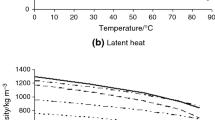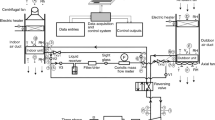Abstract
The present study exports a regression equation which describes the variation of humidity and reduction conductivity of JP8 (F34) with time. A hydrophilic polymer is used to eliminate humidity from JP8 and the regression analysis shows that the maximum decrease of humidity in an hour it is of about ∼39% and conductivity’s in two hours it is of about ∼36% respectively. The elimination of humidity makes the fuel suitable for car machines and gives combustion with less pollution for the environment. Thus, the quality of the fuel as well as its combustion efficiency can be improved while the reduction of water concentration enhances the secure of the combustion machine’s operation.
Similar content being viewed by others
References
C. D. Rakopoulos, D. T. Hountalas, D. C. Rakopoulos, and Y. A. Levendis, Energy Fuels, 18, 1302 (2004).
J. Lee, D. Duddy, M. Thurston, and D. Beardslee, SAE Technical Paper 2011-01-0332, 2011, doi: 10.4271/2011-01-0332.
ASTM D2624-09 Standard Test Methods for Electrical Conductivity of Aviation and Distillate Fuels.
ASTM D2276-06 Standard Test Method for Particulate Contaminant in Aviation Fuel by Line Sampling, 2006.
ASTM D2624-09 Standard Test Methods for Electrical Conductivity of Aviation and Distillate Fuels.
J. Durbin and G. S. Watson, Biometrika, 37, 409 (1950).
R. F. Engle, Econometrica, 50, 1987 (1982).
C. M. Jarque and A. K. Bera, Int. Statistical Rev., 55, 163 (1987).
E. Chuvieco, D. Riano, I. Aguado, and D. Cocero, Int. J. Remote Sensing, 23, 2145 (2002).
M. Xu, Y. Fan, J. Yuan, et al., Int. J. Energy Res. 157 (1999).
D. Carter, D. A. Rogers, and B. J. Simkins, “Does Fuel Hedging Make Economic Sense? The Case of the US Airline Industry,” in AFA 2004 San Diego Meetings, 2002.
G. Cebrat, A. Karagiannidis, and A. Papadopoulos, Management Environ. Quality: An Int. J., 19, 740 (2008).
C. G. Tsanaktsidis, S. G. Christidis, and G. T. Tzilantonis, Int. J. Environ. Sci. Development 2, 8 (2011).
I. N. Grishina, S. T. Bashkatova, I. M. Kolesnikov, and A. Marvan, Pet. Chem., 49, 512 (2009).
Author information
Authors and Affiliations
Corresponding author
Additional information
The article is published in the original.
Rights and permissions
About this article
Cite this article
Tsanaktsidis, C.G., Christidis, S.G., Sariannidis, N. et al. Regression analysis about humidity elimination and reduction conductivity from JP8 via a hydrophilic polymer. Pet. Chem. 52, 447–451 (2012). https://doi.org/10.1134/S0965544112060138
Published:
Issue Date:
DOI: https://doi.org/10.1134/S0965544112060138




